
ARCHIVED PAGE - PLEASE READ!
This page was written by me a long, long time ago. As such the quality of the writing, photography and/or any conclusions I may have come to simply do not stand up to the levels I consider necessary these days.
I do not believe in deleting things outright though as I feel that these pages form something of a time capsule from an earlier stage in my life, and may still be of some interest to folks who have been coming here for a long time. So instead of deleting this page it has been archived.
PLEASE NOTE THAT THIS PAGE HAS BEEN ARCHIVED, AND SHOULD BE CONSIDERED "FOR INTEREST ONLY" AND NOT BE USED FOR ANY OTHER PURPOSE. LINKS, PRICING ETC ARE LIKELY TO BE OUTDATED AND WILL NOT BE UPDATED.
LumaRay FL-12. Rating: 90%

The FL-12 is the second product to be reviewed here from LumaRay. It is a sturdy plastic bodied flashlight featuring the same futuristic body design and advanced features as the FL-6 - clever head release system and custom designed optics to name the best, but twice as many LED's as its predecessor. And it looks like a light sabre...or at least I think it does...enough of that though, on with the review.
Product Info:
| Manufacturer: | LumaRay |
| Available from: | Manufacturer's website - Link removed as website is no longer active. |
| Price: | US$119.95 |
| Size: | 21.5 x 5.5cm |
| Number of lamps: | 12 |
| Lamp Type: | 5mm LED (Nichia CS series) |
| Relative brightness at beam centre*: | 1150 |
| Lamp Current: | Unknown - to be measured |
| Lamp Colour: | White. |
| Body finishes available: | Plastic (GE Xenoy™) - Gunmetal colour. |
| Battery type: | 3 C-size. Alkaline recommended. |
| Switch Type: | Twist bezel on/off. No intermittent or lockout modes. |
| Water Resistance: | Waterproof. Submersible to 15 feet. |
| Approximate Beam angle: | Estimate - Primary beam: 5° secondary: 15° |
| Notes: |
Light
is supplied with instruction manual only, no accessories are included.
Several sections of the text on this page have been almost directly lifted from my review of the LumaRay FL-6. This is due to the fact that the light uses the same body, and therefore several aspects are the same. It is not just me being lazy! |
| Review Date: | 12th July 2005. |
| Related pages: | LumaRay FL-6 Review. |
* Relative brightness here is simply a reading taken from the lightmeter on my camera, it's not frightfully accurate, and isn't in any discernable unit - however it allows some comparison to be made between lights reviewed here - I WILL replace this with an actual intensity reading when I get a lightmeter - when I find one I can afford.
Beamshots from 1 and 5 metres. Colour balance set to "daylight" unless stated otherwise. Divisions on target are at 10mm intervals.
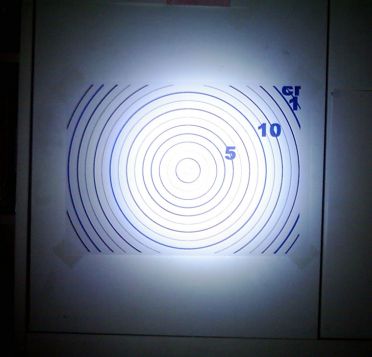
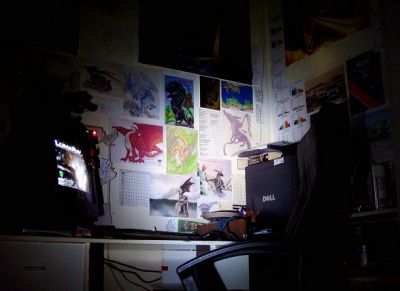
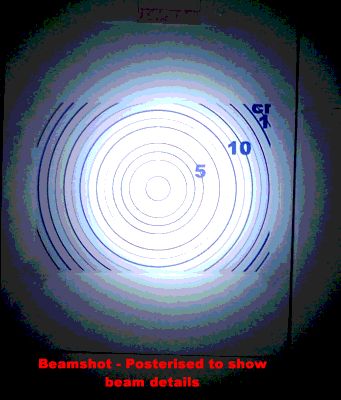
Packing:
Before you even open the box, the originality of the FL12's design is apparent. It is supplied in a box shaped like a triangular prism, which unfolds smartly to reveal your shiny new FL12 and its instructional leaflet, sealed inside a plastic bag. The box only requires a couple of bits of sticky tape to be cut with something sharp (A fingernail will do, especially if you have claws like mine), then a cardboard retaining tab to be removed, then the whole thing unfolds as shown below. There are a number of mysterious holes in the box - these appear to be entirely decorative, as they show nothing of the light inside, but they are an interesting feature nevertheless. The FL12's packaging appears to be identical to that of the FL6, aside from a small graphic showing the differing model number.
Obviously, the box it comes in is far from the most important part of the light - but it is nice to see that LumaRay have actually taken time to think about it. This is a product which is making a point of looking good as well as being a functional tool, and initial impressions are important there.
The durability of this packing has also been proved now, as two of these packs have made their way all the way from the United States to me in Scotland in perfect shape. Usually things which one would normally consider to be pretty sturdy end up pretty mangled unless packed in such a manner as to increase their weight tenfold!

Power Source:
The
FL12 is powered by three common alkaline C cells. The light is not
supplied with them (probably to reduce shipping costs as much as
anything), so you'll need to go out and buy some, then install them
before you can start testing out your new light
sabre...er...flashlight, sorry. Once you have the cells for it, fitting
them is relatively simple - the procedure following sounds a great deal
more complicated than it actually is - it's far, far more
self-explanatory when you have the light in your hands.
1. Stand the light on a flat surface (like a desk) with the bezel
pointing up. Locate the locking collar - this is the thing with the
three rods from the cantilever assembly attached to it - right at the
top of the battery tube. Grip this and rotate it anti-clockwise.
2. Get a decent hold of it, and press downward firmly (this is why it's
easier to do on a desk - a reasonable amount of force is needed to
compress that spring - yes, the one you can see. It is actually a
functional component). The head should now lift itself a little if
there are batteries installed, if not, while still holding the collar
down, lift it off. The pic below shows you what to get a hold of -
despite my thumb being in the way.

3.
Dump out the old cells if there are any in there. You may have to shake
the light to get them out, as LumaRay have intentionally fitted an
O-ring to stop the cells falling straight out. This may seem a bit of a
faff initially - but trust me, if you've ever dropped C or D cells on
your bare toes when changing them in the dark, you'll realise what a
good idea having them unable to fall out actually is! The last one can
sometimes be a real pig to get out, requiring the light to be smacked
against the palm of a hand or shaken somewhat violently. Simple enough
though.
4. Install three new C cells, negative end toward the tailcap. There's
a decent spring in there, so you can safely drop the cells straight in
without worrying about breaking anything.
5. Press the head back on - if it won't fit, rotate it through 30
degrees or so and try again. Very occasionally the switching assembly
will line up incorrectly and prevent the head from fitting. This
doesn't indicate a fault - just turn the head and try again. The head
will click into place audibly when it's right on.
6. Rotate the locking ring found in step 1 clockwise until it stops to
lock everything up. Then you're good to go.
As I said earlier, it sounds a lot more complicated than it is - once
you've done it once you'll see what I mean. Carrying out a battery
change in total darkness isn't a problem at all (so long as you don't
lose the head - which given that it glows would be rather difficult I
reckon!).
I always recommend running lights on a decent brand of cells, despite
the price, I am a great fan of the Duracell Ultra M3 type, as they seem
to give excellent runtimes in all types of situation. The Tesco cells
seen here are just used for photographic purposes as they're all I had
handy!
LumaRay state the runtime as being around 8 hours at high
brightness, with that falling off gradually over the next 400 or so
hours...and given the capacity of modern C cells and given that this
light is pulling a relatively small amount of current, that sounds
reasonable to me. It won't be very bright after a hundred or
so hours, but it will still be going.
I have not had the opportunity to test the FL6 or FL12 with
rechargeable cells, as I do not possess any C size rechargeables. It
does not state in the instruction manual that they cannot be used
though, and I can't see why they would not. The light may start out
slightly dimmer though. The flatter discharge characteristic
of rechargeables may also present a bit of a problem, as the light
would tend to go out very quickly rather than dimming over time.
Lamps:
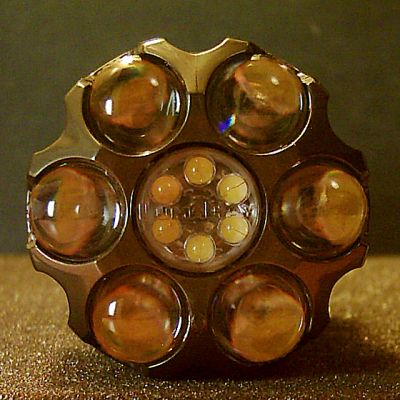
The FL-12 (as the number in the name suggests) uses 12 LED's to produce its light. While many lights this sort of size would be using Luxeon Star emitters or other high power LED's, LumaRay decided to opt for the older 5mm type. Don't be fooled however, the clever optics aside, these aren't your normal garden variety 5mm LED's. These are Nichia's newest and best, the CS series LED's, and boy are they bright! A very clever feature of this light is also that the LED's themselves are not the only things in this light producing light. A powerful and long lasting glow in the dark compound has been applied to the area behind the LED's in the FL6 and FL12. This glow, though obviously nowhere near as bright as that from the LED's themselves is quite bright enough to act as a locator for the light in a darkened room. It is very clearly visible for over ten hours after the light is turned off if your vision is dark adapted. The fact that it's a green colour helps too, as scotopic vision is most sensitive to light in this part of the spectrum. LumaRay have even put thought into the colour of this too, as the GITD compound used in the FL12 is much greener in colour than that of the FL6 - and I have confirmed that this is a deliberate difference, so that the lights can be differentiated from each other in the dark. A photograph below shows them compared to each other.
As if the use of a glow in the dark locator and some very high quality LED's weren't enough, LumaRay went and included some ingenious optical design into the FL12 as well. As can be seen above, six of the twelve LED's are behind magnifying lenses, these focus the light from them into a very long throwing beam, with virtually none being wasted off to the sides. However, this alone leads to a very narrow beam, which is often less than ideal (this was my only real issue with the FL6). Not here though! LumaRay have addressed this by having the other six of those LED's (the ones in the middle) behind a simple clear window which allows them to cast a gentle flood - no more tunnel vision!
Nice one with the optical design I say to those at LumaRay who came up with this! It's an idea many companies have tried before without really managing it - you however have, with style.

Operation:
The FL6 is a very simple light to operate. No fancy multi-function switches, no brightness level controls or anything. Just a conventional twist-bezel switch. Holding the light so that it's facing away from you (because shining it in your eyes REALLY ain't such a good idea - it's rather bright at close range...and not quite so close range for that matter), simply twist the head anti-clockwise (or the body the other way) to get light, and turn it clockwise to get not light. Simple as that. There is no momentary (signaling) operation mode on this light, so don't look for one, nor is there a lockout function. Though I don't find this type of switch too prone to accidental activation anyway, so it isn't a great loss.
Ergonomics:
It has to be said, that the FL12 is an unusual looking thing. There are a lot of exposed functional things - a big spring for the release collar, ball joints for the same, and the aluminium pins on the tailcap. Despite these things however, the FL6 is actually very comfortable to use; whether in a conventional or a tactical grip. The body is slightly tapered (wider at the tailcap than at the top of the barrel), and just the right diameter to feel comfortable in the hand. It's just the right weight too, heavy enough to feel reassuringly solid (especially for a plastic bodied light), yet not heavy and clunky like many metal bodied lights this sort of size can, the point of balance being just on the join between the head and body, so it's perfectly balanced in your hand. Despite the smooth texture of the body, the aforementioned shape combined with all the things to get a hold of on the head mean that keeping hold of the light with wet, cold or oily hands shouldn't be too hard. Some texturing *would* help though. However, keeping hold of lights is what lanyards are for, and while the FL6 is not supplied with one, there are a number of attachment points for one provided on the tailcap.
It
isn't a lightweight light which you're going to stuff in a pocket and
not notice the presence of, but it's pretty light for a 3-C cell light,
and certainly won't cause you problems if you throw it in a backpack or
anything, or give you muscle fatigue when carrying it in your hand.
The only ergonomic downside related to the rather nifty looking release
mechanism for the head. While it looks good, it also loves to catch on
things, especially pockets when you're trying to get the light out in a
hurry. That and that fluff just loves to accumulate behind there too.
It's not a major gripe, but it can be a little frustrating when you go
to get the light out and it decides to stop to have a conversation with
your pocket first.
The aforementioned linkages on the release mechanism combined with the
flutes in the head serve as a very simple but effective anti-roll
device. If you put this light down on any surface it'll stay put,
rather than rolling off into the distance like some other lights can.
The switch position works well, and unusually for this type of switch,
it is actually quite easy to operate the light one handed thanks to the
large indentations on the bezel's perimeter. Granted, it's a bit stiff
when trying to use a finger or thumb to turn it on or off, but not
overly so. Keeping the O-rings well lubricated will help
greatly with this.
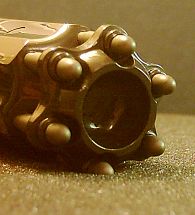
Performance:
I think LumaRay - though they haven't said anything about it to my knowledge - wanted to make a statement with this light. That 5mm LED's CAN still compete with Luxeons for output in a light of this type...and much to my surprise, they've pulled it off! The FL12 is really rather bright, easily managing the match the sort of light output you would expect from an incandescent flashlight this sort of size, and then some. Not only does it manage to achieve light levels like that - it does so for a long, long time - and with a pure white beam which *stays* white as the cells discharge. The beam from the FL12 is a rather unique example, this light can easily illuminate objects out of the range of LED lights which do not use optics to focus the beam (with the beam from the lensed LED's), but at the same time having a beam which is quite usable for closeup work thanks to the six unlensed LED's. This is where the FL6 used to have problems, in that while it had a good tight beam for the spotlight purpose, it provided very little illumination outside that main beam - precisely what has been addressed here. Performance wise, this light is very, very capable of serving the purpose of the 3C cell version of a popular aluminium bodied flashlight we all know (no names, no lawsuits), and in my opinion, doing a better job of it too.

The beam from this light also deserves a mention for its colour. This is by far the whitest beam I have seen from an LED light to date. There is a slight blue ring caused by the optics - and that's something impossible to avoid with an optical system of this type - but other than that is a completely white example, it's a cool white, but not blueish at all (as most beams produced by 5mm LED's are) - if anything, I'd say this beam reminds me of what you'd consider typical of a metal halide discharge lamp of a similar colour temperature.
A year or so ago, it was considered fact that a 1W Luxeon Star put out slightly more light than 10 5mm LED's. Oh how things have changed. The comparison below shows the FL12 compared to a Heliotek HTE-1. Which is using a good 1W Luxeon Star LED. It can be clearly seen that the FL12 is giving out quite considerably more light. The image has been altered in Photoshop, yes - but that's just because my camera isn't the greatest thing known to man - the image there is exactly as the brightness levels appear to the eye. The triangular thing at the top of the image should be ignored, that's my lightshade, as that's my ceiling.

Durability Department:
Okay.
Take those visions of the £1 plastic flashlights which shatter the
first time you drop them, and get them out of your head right now. This
thing is tough. This isn't quite so surprising when you take into
account that the light here is made of a combination of GE Xenoy™
(body), polycarbonate (optics), stainless steel (contact springs) and
high grade aluminium (tailcap pins and balljoints on the head release
mechanism). This is really about as though as plastic bodied lights get.
The usual impact tests were conducted; firstly dropping the light from
waist height to the floor (thinly carpeted wood), secondly throwing
across the room from the same height - imitating losing hold of the
light when running with it. It shrugged off both of these tests without
even breaking a sweat. Though it *did* roll under the bed after the
second test, and took me twenty minutes to get it out again. I wouldn't
want to try running this over with a car, or throwing it off a cliff,
but I can safely say that it'll shrug off everyday mishaps without
trouble. It *will* however pick up scratches quite rapidly if it's kept
for example, in a toolbox though. That won't affect the operation of
the light itself, but scratching up the optics will broaden the
beam. The only possible point I could see as a weakness is
where the stainless steel pins at the tail end of the light enter the
body - if the light were to be dropped from any significant height onto
something like a concrete or a tiled floor, there's going to be a lot
of force concentrated on the area where the aforementioned pin enters
the body of the light - it MAY be possible for a crack to form
there. I very much doubt this would cause the light to
malfunction, but it would look a mess, and may compromise the
waterproofing. Certainly isn't something I can see happening
in normal use though - just that in extreme conditions, that's where I
might expect to be the weak point on this body design.
One thing I did notice when conducting these tests is that when the
light is dropped tail-first (or even just put down quickly on a hard
surface that way) it may briefly flicker slightly. This is
NOT a fault, it is simply the weight of the batteries compressing the
spring at the tail end of the battery tube momentarily breaking the
contact between the head and the positive nipple of the
batteries. This actually happens with most incandescent
lights also using more than two C or D cells, it's just that because an
incandescent bulb takes a lot longer to go out than an LED, you don't
see it. This is not a fault with this light, and being
totally honest, really isn't noticeable. I only found it
because I was looking for it - I am a reviewer afterall, it's my job to
notice things like that!
The light is sealed at the head by no less than two O-rings, and is
stated in the instruction manual as being waterproof to no less than 15
feet. It survived spending three hours submersed in the bath here, so
no worries there about using it in foul weather. Probably best not to
take it diving though as it's only rated to 15 feet. The lack of
complex electronic drive circuitry means that even it the light did
flood, so long as you dry it out pretty quickly (and rinse it out
properly with clean water if it got salt-water in) before reassembling
it you should be fine. The contacts are stainless steel, so should
resist corrosion even in a situation like that. Occasionally
lubricating the O-rings with silicone grease should be all that's
necessary to maintain the waterproof rating.
Overall:
You remember my FL6 review? The fact that I really liked it, but had a couple of reservations...well, LumaRay here appear to have gone and maintained all the good points of the FL6, and have addressed all of them. The FL12 is in my opinion a very, very good light. The unique styling will not appeal to everyone, but I think it's a good point. It's really nice to see a product like this which not only works well, but has been nicely designed visually as well - not only looking nice, but looking unique.
The FL12 is a solid performer as well, with a very user-friendly beam, good battery life, and is cheap to run, thanks to the use of common and cheap cells. The only thing really stopping this light from being the sort of thing the general consumer's likely to rush out and buy instantly is the price. There's only a limited market who can afford to pay over $100 for a light, those who can though, I recommend this one.
Pros:
+Good brightness
+Very useful beam pattern
+Long battery life
+Uses cheap easy to find batteries
+Water resistant
+Fairly light for its size
+Durable
Cons:
-...Er, really nothing I could think of!
Niggles:
>As with the FL6, there is some light which can be seen leaking out of the back of the bezel when in operation, some people may find this objectionable.
Ratings:
Beam Quality: 10
Build Quality: 10
Battery Life: 9
Durability: 8
Value: 8
Overall: 45 / 50 = 90%
Many thanks to Ed at LumaRay for providing this light for review!
Long Term Testing:
15th July 2005: Review uploaded in full. Long term testing continuing. Hopefully I will have something to add here, as this light is in daily use. It is really rather handy!
7th December 2008: Fixed links to old server and some dodgy page formatting. The FL-12 is still in regular use to this day. It looks a bit more beat up now, but is still working well. The only niggle which has been highlighted is a bit of a tendency to flicker when shaken. Sticking a couple of sheets of paper down the barrel to stop the cells from being able to move solves this problem completely.
3rd August 2009: Sorted some dodgy page formatting and links to the old server.
5th January 2021: Page retired and moved to Site Archive. This flashlight is STILL in regular use though!
28th April 2023: Revised Statcounter code to allow for HTTPS operation.
6th April 2025: Removed some dead links to the maker's website which is no longer operating.